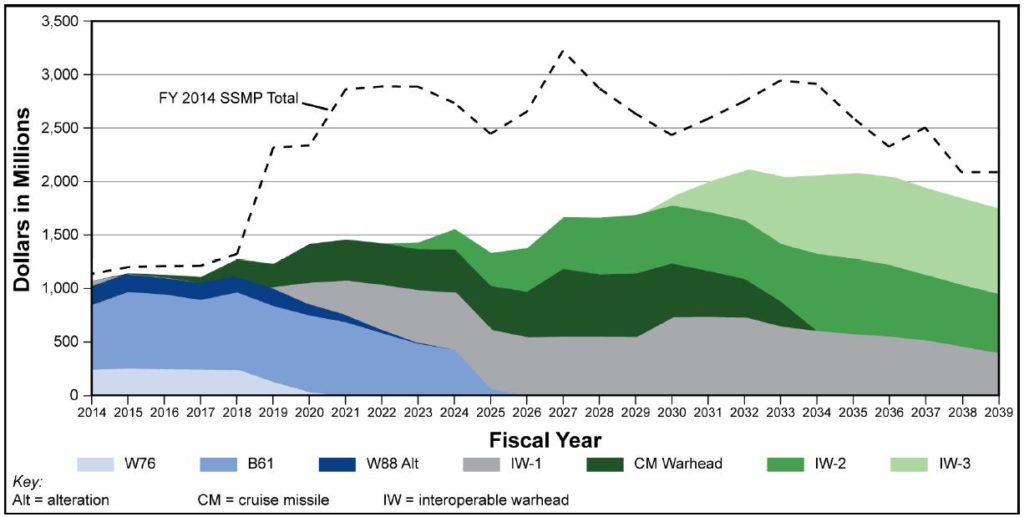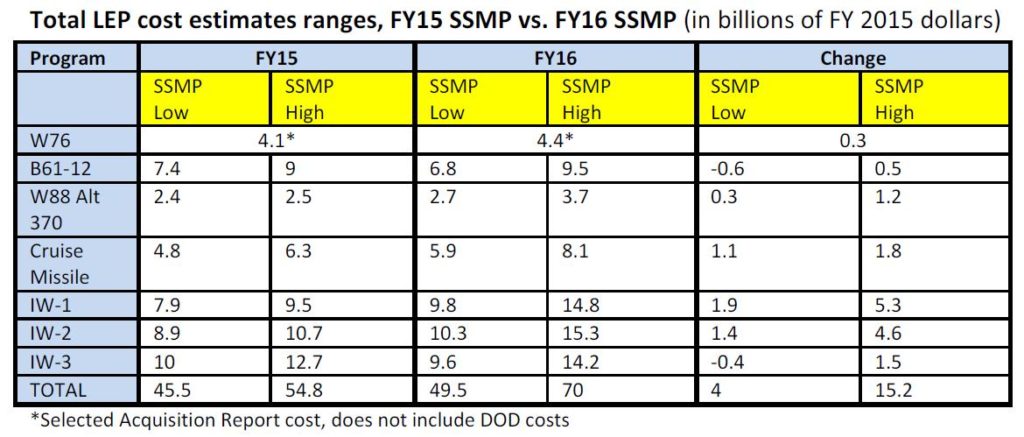Written with Stephen Young
The FY16 Stockpile Stewardship and Management Plan (SSMP), released in March, is the latest in a series of these reports published annually by the National Nuclear Security Administration (NNSA), the semi-independent agency that oversees production and maintenance of U.S. nuclear warheads, as well as the infrastructure required for these activities.

(Source: tzunghaor)
The report updates the “3+2” plan for the future of the U.S. arsenal, which involves reducing the number of types of nuclear warheads in the U.S. stockpile from the current seven to five: three “interoperable” ballistic missile warheads to be used on land- and submarine-based ballistic missiles, and two air-delivered weapons (a gravity bomb and a cruise missile warhead). Hence the name “3+2,” although the NNSA notes it is really only the nuclear explosive packages—the fissile materials that go boom—that will be interoperable; many of the non-nuclear components will be different for the land- and sub-based versions.
Thus, it might be more appropriate to call the plan “6+2.”
FY14 cost estimates
One of the most interesting storylines about the 3+2 plan has been what this new approach to maintaining the stockpile will cost. When the plan was first introduced in the FY14 SSMP, it was not described as saving any money. The focus was on reducing the total number of warhead types through common components and reducing the size of the hedge (those warheads kept in reserve in case they are needed).
Indeed, the cost estimates for the 3+2 plan were notably high, on the order of $60 billion (in then-year dollars) over the first 25 years. Given that the cost to update the W76 warhead, which is the most common warhead in the stockpile, was only around $4 billion, the cost led many outside experts—and some in the administration—to have real concerns about the affordability of this new program.
FY15 cost estimates
In the FY15 SSMP, the NNSA’s storyline changed considerably, with the agency stating that “the 3+2 strategy reduces the total long-term NNSA costs through decreased LEP [life extension program] costs.” It claimed this based on a comparison to an earlier plan, laid out in the FY11 SSMP, which called for simply carrying out LEPs on existing warheads, rather than building new interoperable warheads.
Simultaneously, the NNSA provided new cost estimates for the 3+2 plan that were dramatically lower than those given in the FY14 SSMP, as the chart from the FY15 SSMP below clearly shows.

Comparison of LEP cost estimates in FY14 vs. FY15 SSMPs (Source: FY15 SSMP, Fig. 8-21. Amounts in then-year dollars)
Surprisingly, these reduced costs seemingly came without significant cutbacks in the planned activities; in many cases, the programs actually increased in complexity while still decreasing in projected cost—the interoperable warhead programs are a prime example of this phenomenon.
To explain the lower estimates, NNSA simply offered a modest statement noting “The principal differences between the FY 2014 and FY 2015 estimates are the adjusted timing of the cruise missile and interoperable warheads, the adjustment in the escalation factor from the 3.4 percent value used in the FY 2014 SSMP estimates to the OMB-recommended level (2.11 percent), and improvements in the cost models for future life extensions.”
Since we can account for both the timing shift and the different escalation factors by comparing cost estimates in same-year dollars, the remaining differences must be due to the difference in cost models, and it appears that these unspecified “improvements in the cost models” actually account for most of the change. But it is unclear how this would lead to such dramatic reductions in cost estimates.
FY16 cost estimates
However, in the FY16 SSMP, the NNSA’s storyline changes again. This latest report drops any mention of reducing cost as a benefit of 3+2. Instead, it states that, “when fully implemented, the 3+2 Strategy will reduce the number of weapon types, reduce the number of weapons in the deployed stockpile, simplify maintenance requirements, and reduce the number of weapons retained as a hedge against technical failure.”
In keeping with dropping the claim of long-term cost reductions from 3+2, the FY16 SSMP budget estimates for the LEPs and new warhead programs that make up 3+2 show an overall increase from the estimates in the FY15 SSMP.
The SSMP states that the cost estimates for the interoperable warheads (IWs) have increased in part because the Air Force and Navy have decided to use different arming and fuzing mechanisms for these weapons.
The FY16 SSMP also uses a new method of estimating costs, one that the NNSA believes is more accurate. The NNSA states that one difference in the cost evaluation is that the FY16 SSMP included input from “a broad ranging and highly integrated team of subject matter experts from the national laboratories and the nuclear weapons productions facilities,” which added greater technical expertise on the individual LEPs and new warhead programs to help in providing a more accurate understanding of the degree of complexity, and thus, uncertainty, the programs may face.
Based on this method, the FY16 SSMP shows projected costs for life extension programs to be higher than the FY15 estimates, though in most cases still not quite as high as those projected in the FY14 SSMP.
The FY15 SSMP estimates for the total cost to complete all the programs that make up the 3+2 plan ranged from $61 billion to $75 billion dollars (in then-year dollars). (Although the estimated cost of 3+2 in the FY14 SSMP totaled roughly $60 billion, this included only costs between FY14 and FY38, not the full life of the programs, which in some cases are planned to extend a decade or more beyond FY38.) The FY16 SSMP estimates a total cost ranging from $66 billion to $95 billion (in then-year dollars)—a significant jump from the FY15 estimate.
However, it is more useful to compare the budget figures in constant dollars. The FY14 SSMP did not provide these figures, but the FY15 and FY16 plans do. Below are the numbers in FY15 dollars (note that FY14 and FY15 dollars are equivalent because inflation has been so low).
This projected increase in costs, combined with the fact that the NNSA plans to carry out multiple warhead programs simultaneously during the 2020s, creates a serious budgeting problem for the agency. The SSMP itself acknowledges this, blandly noting that “The cost estimates for the currently approved stockpile work, as recommended by the Nuclear Weapons Council and adopted by the Administration, and estimated infrastructure modernization efforts exceed the projected budgetary resources for the Weapons Activities account in several years beyond FY 2020.” How this problem will be resolved remains an open question.
It is also worth bearing in mind that many of these programs have not yet begun, and even if they remain on schedule will continue for decades into the future, so there is a high degree of uncertainty in the estimates. But given historical experience with NNSA programs, it is a safe bet that the trend will not be downward.

